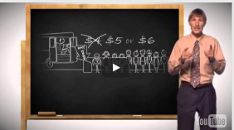Hillsdale College has produced a free economics course, Economics 101: The Principles of Free Market Economics, which can easily serve as a one-semester economics course for high schoolers with some supplementation. The course includes a final exam and a certificate of completion for those who pass, although no college credit is awarded.
The course is presented in ten lessons. Lesson titles themselves give you a good idea of the free-market, limited-government perspective advanced by this course. Lesson titles are:
- Free Market Economics and the American Founding
- How Markets Work
- Understanding Demand
- Supply and Equilibrium
- The Role of Profit
- Incentive and the “Information Problem”
- Keynesianism and Macroeconomics
- Monetary Theory
- Case Study: The Great Recession
- Restoring Economic Liberty
Larry Arnn, President of Hillsdale College presents the first and last session while Gary Wolfram, William E. Simon Professor in Economics and Public Policy at Hillsdale College, presents the rest.
Each lesson has two or three videos plus recommended reading. The first video for all of Wolfram’s presentations is a brief introduction, generally running just a few minutes. The main lecture for each lesson averages about 30 minutes. A question and answer interview for each lesson should be watched after the main lecture since discussion there generally homes in on specific topics brought up in the main lecture. These run 20-30 minutes each. The primary lecture and the Q and A session are also available as audio files, but the introductory segments are not. Videos sometimes use a blackboard or whiteboard for diagrams and explanations, so I strongly recommend that students watch the videos rather than just listen to audio presentations. videos are filmed with two or three cameras, so they are not static "talking head" type videos. Nevertheless, these are still lectures as might be experienced in a classroom.
The course covers the basics of macroeconomics, but it does so with many references to historical and current events that help students understand economics in action. For example, Wolfram supports the view that government programs inaugurated to pull the United States out of the Great Depression caused more harm than good. He explains the historical situation along with a similar problem that we have at present with government intervention undermining the predictability of markets, causing an uncertainty that dramatically slows business growth.
Arnn’s closing lecture raises some thought-provoking points regarding economic systems and government. For example, he explains how the Founding Fathers were just as concerned about the ability to acquire property as to hold private property. They understood how governments could grant property and favors to selected recipients, with the potential for shutting others out from the possibility of acquiring property—a situation not far different from what many claim is becoming a reality in the United States.
One or two recommended reading assignments for each lesson link to free online articles or excerpts. Most excerpts are from Wolfram’s book, A Capitalist Manifesto. (The book, as well as the course, advances capitalism as the only economic system that is compatible with individual liberty and social justice.) Larry Arnn’s final session is an exception with links to six documents and articles including “The Northwest Ordinance” and “Homestead Act of 1862” which illustrate historical events that buttress Arnn’s position. While the course presents a particular point of view, it backs it up with convincing explanations, arguments, and evidence.
If students watch all of the videos and read all of the recommended reading, which they should, the total number of hours is still short of the 60 to 90 hours typical of what is required for a high school level semester-long course. You might have students read Wolfram’s complete book, A Capitalist Manifesto, which is 152 pages in length. You might include other resources such as Whatever Happened to Penny Candy? or work on personal financial skills and applications through a resource such as Financial Literacy form a Christian Perspective, Money Matters for Teens, or the Official Money Guide for Teenagers.








